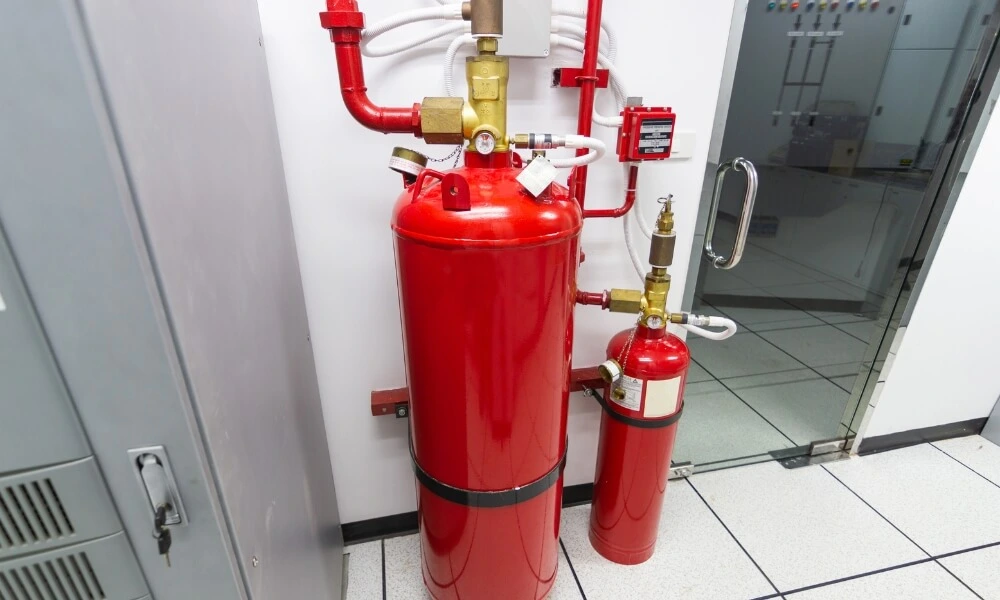FM200, a leading name in the world of fire suppression, has revolutionized the way we protect our assets, infrastructure, and, most importantly, lives. As a clean agent system, FM200 offers rapid, residue-free fire suppression, making it a preferred choice for various industries and environments. This blog delves deep into the intricacies of the FM200 Fire Suppression System, exploring its applications, operational mechanisms, installation procedures, and safety protocols.
Additionally, we’ll provide a comparative analysis with other fire suppression systems, offering a comprehensive understanding of their advantages and suitability for diverse settings. Whether you’re considering implementing a fire suppression solution or seeking to understand the science behind it, this guide promises a thorough insight into the world of FM200.
What is the FM200 Fire Suppression System?
FM-200 is the brand name for a fire suppression agent known as heptafluoropropane (chemical formula: C3HF7). It is a colorless, odorless gas that is used in fire suppression systems, especially in areas where water-based fire suppression could damage sensitive equipment, such as data centers, telecommunications facilities, and museums.
Here are some key points about FM-200:
- Environmentally Friendly: FM-200 is considered an environmentally friendly fire suppression agent because it has zero ozone depletion potential and a relatively short atmospheric lifetime.
- Safe for Occupied Spaces: FM-200 is safe for use in occupied spaces when used in accordance with the recommended design concentrations. It extinguishes fires primarily by removing heat and does not significantly reduce oxygen levels.
- Rapid Extinguishing: FM-200 systems are designed to release the agent in less than 10 seconds, which can quickly suppress a fire before it can spread.
- No Residue: FM-200 leaves no residue after discharge, which means minimal cleanup and no damage to sensitive equipment.
- Space and Weight Efficient: FM-200 systems require less storage space compared to other fire suppression systems, making them suitable for locations with space constraints.
- Applications: FM-200 is suitable for a wide range of applications, including data centers, telecommunications, medical facilities, and more.
- Regulations: FM-200 is approved for use by many international organizations and complies with various standards and regulations.
It’s important to note that while FM-200 is effective and has many advantages, it’s essential to ensure that any fire suppression system is designed, installed, and maintained by professionals to ensure its effectiveness and safety.
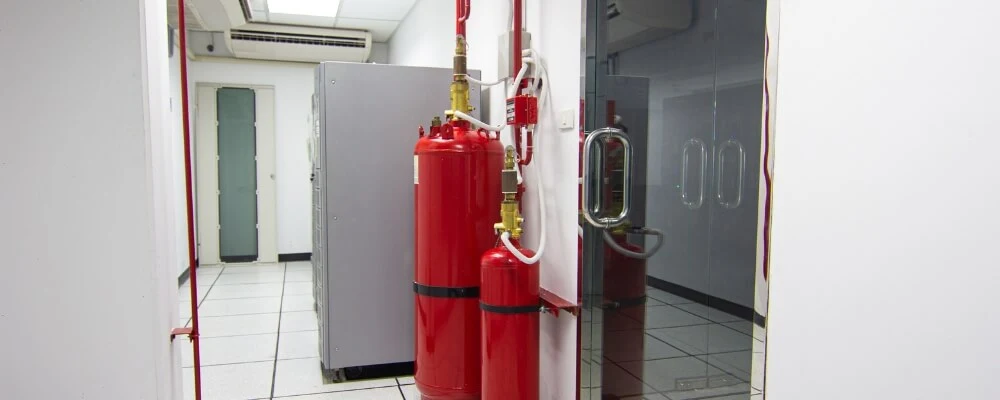
Applications and Suitable Environments for FM-200
The FM-200 fire suppression system is renowned for its efficiency, environmental friendliness, and the fact that it leaves no residue post-discharge. These attributes make it particularly suitable for a variety of applications and environments where traditional fire suppression methods might be less than ideal. Here’s a closer look at where FM-200 truly shines:
- Data Centers: With the increasing reliance on digital infrastructure, protecting data centers from fire is crucial. FM-200 is ideal for these environments because it suppresses fires without causing damage to sensitive electronic equipment. There’s no water to cause short circuits and no residue to necessitate extensive cleanup.
- Telecommunication Facilities: Like data centers, telecommunication facilities house sensitive equipment that can be easily damaged by water or other suppressants. FM-200 ensures that communication lines remain intact even after a fire incident.
- Museums and Archives: Priceless artifacts, documents, and artworks require protection not just from fire but also from the potential damage caused by fire suppressants. FM-200’s clean agent properties ensure that these invaluable items are not harmed during the suppression process.
- Medical Facilities: Hospitals and other medical facilities house critical equipment and patient records. FM-200 ensures that these remain undamaged, allowing for the continuity of care and safeguarding of vital patient data.
- Control Rooms: Whether it’s for utilities, transportation, or other industries, control rooms are the nerve centers of operations. FM-200 ensures that fires are quickly suppressed without damaging controls or causing extended downtimes.
- Aircraft and Marine Applications: FM-200 is lightweight and effective, making it suitable for applications where space and weight are at a premium, such as in aircraft and ships.
- Clean Rooms: Used in industries like semiconductor manufacturing, these environments require absolute cleanliness. FM-200’s residue-free discharge ensures that the stringent standards of clean rooms are maintained.
- Financial Institutions: Banks and other financial institutions house not only electronic data but also physical documents of significant importance. FM-200’s clean suppression ensures the safety of both.
- Historical Buildings: Traditional fire suppression methods can sometimes cause more damage than the fire itself, especially in historical buildings. FM-200 offers a solution that protects the building while preserving its historical integrity.
- Laboratories: With a plethora of chemicals and equipment, labs can be vulnerable to fires. FM-200 ensures that fires are suppressed without causing chemical reactions or damaging equipment.
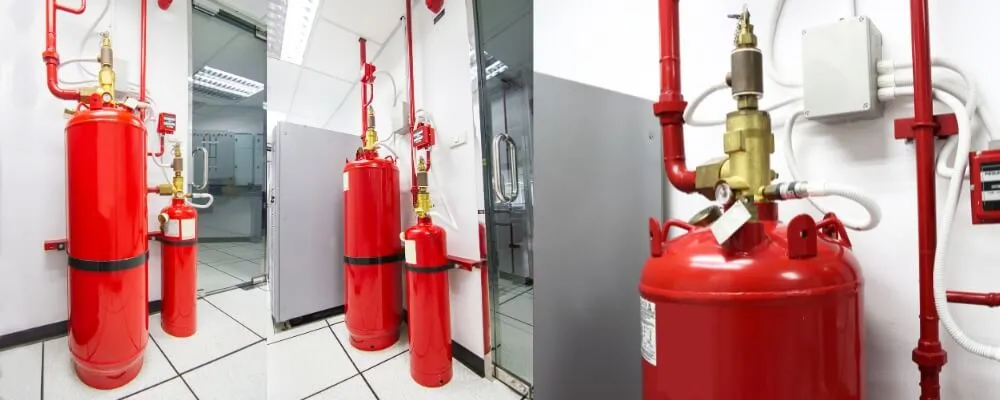
How FM200 Fire Suppression System Work
FM-200 (heptafluoropropane) works as a clean agent fire suppression system. Unlike water or foam-based systems, FM-200 extinguishes fires without leaving behind any residue, making it ideal for protecting sensitive equipment. Here’s how FM-200 works to suppress fires:
1. Heat Absorption
FM-200’s primary mode of action is its ability to absorb heat. When a fire burns, it requires a certain amount of heat to sustain the combustion process. Upon release, FM-200 rapidly absorbs this heat, effectively lowering the temperature surrounding the fire.
As the temperature drops below the threshold required for combustion, the fire is unable to sustain itself and is thus suppressed. This disruption of the fire triangle—comprising heat, fuel, and oxygen—ensures that the fire is effectively extinguished. The speed and efficiency with which FM-200 absorbs heat make it a potent agent against fires.
2. Chemical Interruption
Beyond its heat absorption capabilities, FM-200 possesses a unique characteristic that allows it to interfere with the fire on a molecular level. Every fire undergoes a chain reaction, a series of chemical processes that enable it to continue burning. FM-200 disrupts this chain reaction, effectively halting the fire’s ability to propagate.
This chemical interruption is crucial because it ensures that even if some conditions for combustion remain, the fire’s chemical processes are disrupted, preventing it from spreading.
3. Rapid Discharge
The effectiveness of a fire suppression system often hinges on its speed. FM-200 systems are engineered to release the suppression agent with remarkable swiftness, typically achieving full discharge in less than 10 seconds.
This ensures that the agent is distributed uniformly throughout the protected area in a short time frame. Such rapid deployment is vital in ensuring that fires are suppressed before they have a chance to spread or cause significant damage.
4. Safe Concentration Levels
Safety is paramount when considering fire suppression in occupied spaces. FM-200 is formulated to work at concentrations that are non-hazardous to humans. While it effectively reduces the heat and disrupts the fire’s chain reaction, it does so without depleting oxygen levels to a dangerous point.
This characteristic ensures that, in the event of a discharge, individuals within the affected area can safely evacuate without the risk of asphyxiation.
5. No Residue
In environments housing sensitive equipment, the aftermath of fire suppression can be just as concerning as the fire itself. FM-200 stands out because it evaporates completely after discharge, leaving no residue behind. This is invaluable in places like data centers, museums, or medical facilities, where the residue from other suppression agents could be detrimental to equipment or artifacts.
6. Total Flooding
FM-200 systems are typically employed in what’s known as a “total flooding” application. This means that, rather than targeting a specific area or source of ignition, the agent is released to fill and protect the entire designated space. By doing so, it ensures that all potential ignition sources within that space are addressed, providing comprehensive fire protection.
In essence, FM-200’s multifaceted approach to fire suppression, from its heat absorption and chemical interruption capabilities to its rapid discharge and residue-free properties, makes it a highly effective solution. Its ability to act quickly and comprehensively ensures that fires are not only suppressed but prevented from reigniting or spreading further.
Total Flooding is a particularly strategic approach for fire suppression. By filling the entire protected space with FM-200 it ensures that no corner or crevice is left unprotected. This is especially crucial in environments with complex layouts or where fires might originate from multiple sources. The total flooding method ensures a holistic approach, leaving no room for fires to hide or escape the suppression agent.
Moreover, the safety profile of FM-200 is noteworthy. In many fire scenarios, the danger isn’t just from the fire itself but also from the suppression method. Water can damage electronics; foam and powder can contaminate environments and require extensive cleanup. FM-200, on the other hand, offers a clean solution. Its ability to suppress fires without leaving any residue means that once the danger has passed, operations can resume without extensive cleanup or the risk of damage to sensitive equipment.
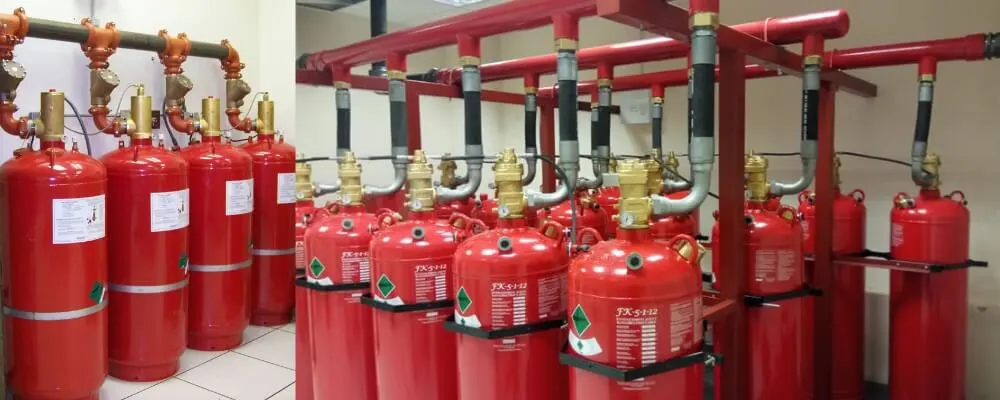
FM-200 Installation and Maintenance
Implementing an FM-200 fire suppression system requires meticulous planning, installation, and maintenance to ensure its effectiveness and safety. Here’s a comprehensive guide on the installation and maintenance of an FM-200 system:
Installation
- Risk Assessment: Before installation, a thorough risk assessment of the facility is essential. This helps in determining the potential fire hazards, the volume of the protected area, and any specific requirements or challenges the space might present.
- System Design: Based on the risk assessment, a system design is created. This includes determining the amount of FM-200 required, the placement of nozzles, detectors, and alarms, and the layout of piping.
- Cylinder Placement: FM-200 is stored in cylinders as a liquid. These cylinders should be placed in easily accessible locations yet away from potential hazards. Depending on the design, they can be placed within or outside the protected area.
- Piping Installation: The piping is crucial for delivering FM-200 from the storage cylinders to the protected area. It should be installed in a way that ensures even and rapid distribution of the agent.
- Detector and Alarm Installation: Fire detectors, typically smoke or heat detectors, are installed throughout the protected area. These detectors are connected to a control panel that triggers the FM-200 discharge when a fire is detected. Alarms are also installed to alert occupants of the fire and the impending discharge.
- Initial Testing: Once everything is installed, the system undergoes a series of tests. This includes a “puff test” to check for obstructions in the piping and an electronic test to ensure all detectors, alarms, and control panels are functioning correctly.
Maintenance
- Regular Inspections: Periodic inspections are crucial to ensure the system’s readiness. This includes checking the physical condition of cylinders, piping, nozzles, detectors, and alarms.
- Weight Checks: The FM-200 agent’s weight in the cylinders should be checked regularly to ensure there’s no leakage and that the correct amount of agent is present.
- Functional Testing: Detectors and alarms should be tested to ensure they function as expected. This doesn’t involve discharging the FM-200 but rather simulating a fire scenario to check the system’s response.
- Integrity Testing: Especially important for enclosed spaces, integrity tests ensure that the protected area can hold the FM-200 concentration long enough for it to suppress a fire effectively. This typically involves checking for leaks or areas where the agent might escape.
- Training: Facility staff should be trained on the system’s operations, what to do during a discharge, and basic troubleshooting. This ensures a swift response during emergencies.
- Service and Repairs: If any component of the system is found to be malfunctioning or damaged during inspections or tests, it should be serviced or replaced immediately. This might involve replacing worn-out detectors, fixing leaks in the piping, or recalibrating the control panel.
- Documentation: Maintaining a detailed log of all inspections, tests, and any interventions is crucial. This log can provide a historical record of the system’s performance, highlight recurring issues, and serve as a reference during regulatory inspections.
- Recharge After Discharge: If the FM-200 system is activated and the agent is discharged, it’s essential to recharge the system with the correct amount of FM-200 as soon as possible. This ensures that the facility remains protected against any subsequent fire threats.
- Updates to System Design: Over time, the layout or usage of a facility might change. If there are significant changes, such as the addition of partitions or the introduction of new equipment, the FM-200 system design might need to be updated to ensure continued effectiveness.
- Compliance with Regulations: Fire suppression systems, including FM-200, are subject to local, national, and sometimes international regulations. Regular audits or inspections might be required to ensure compliance. Staying updated with these regulations and ensuring the system adheres to them is a critical aspect of maintenance.
- Component Lifespan: While FM-200 systems are designed for longevity, individual components have their own lifespan. For instance, detectors might need replacement after a certain number of years, or the FM-200 agent itself might need to be replaced after a specific duration, even if not discharged. Being aware of and proactive about these lifespans ensures the system remains in peak condition.
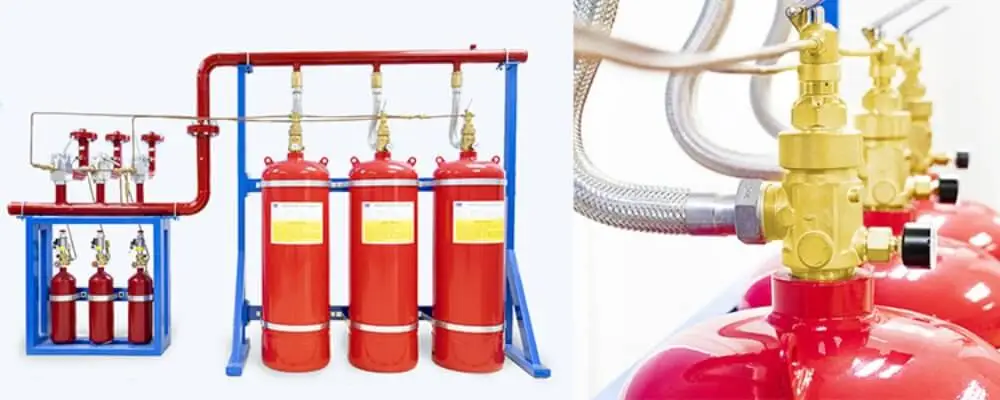
Safety Considerations for FM-200 Fire Suppression Systems
While FM-200 is renowned for its effectiveness and environmentally friendly properties, it’s essential to consider various safety aspects when implementing and using this fire suppression system. Here are some key safety considerations:
- Occupant Safety: FM-200 is designed to suppress fires at concentrations that are safe for humans. However, it’s crucial to ensure that the system is designed and maintained to release the agent within these safe concentration limits. Ensure clear egress paths so that occupants can quickly and safely exit the area in the event of a fire or system discharge.
- Audible and Visual Alarms: Alarms should be installed to alert occupants of fire detection and impending FM-200 discharge. This gives individuals time to evacuate the area before the agent is released.
- Avoiding Re-ignition: After a fire has been suppressed, it’s essential to identify and eliminate the source of ignition to prevent re-ignition once the FM-200 concentration decreases.
- System Training: Facility staff and occupants should be trained on the operation of the FM-200 system, the sound of alarms, and the appropriate actions to take during a discharge. This ensures everyone knows how to respond during an emergency.
- Integrity Testing: Regular integrity tests should be conducted to ensure that the protected area can maintain the FM-200 concentration for the required duration. This ensures the agent’s effectiveness in suppressing fires.
- Regular Maintenance: As with any system, wear and tear can compromise safety. Regular maintenance checks ensure that all components are functioning correctly and safely.
- Avoiding Accidental Discharge: Properly securing the control panel and other system triggers can prevent accidental discharges, which could be disruptive and costly.
- Safety Data Sheets (SDS): Always have the Safety Data Sheet for FM-200 accessible. It provides crucial information about the agent, including its properties, potential hazards, and first-aid measures.
- Ventilation: After a discharge, even though FM-200 is safe, it’s a good practice to ventilate the area to ensure a swift return to normal conditions.
- Protection Equipment: In areas where there’s a higher risk of fire or where higher concentrations of FM-200 might be used, consider providing occupants with protective equipment like masks or breathing apparatus.
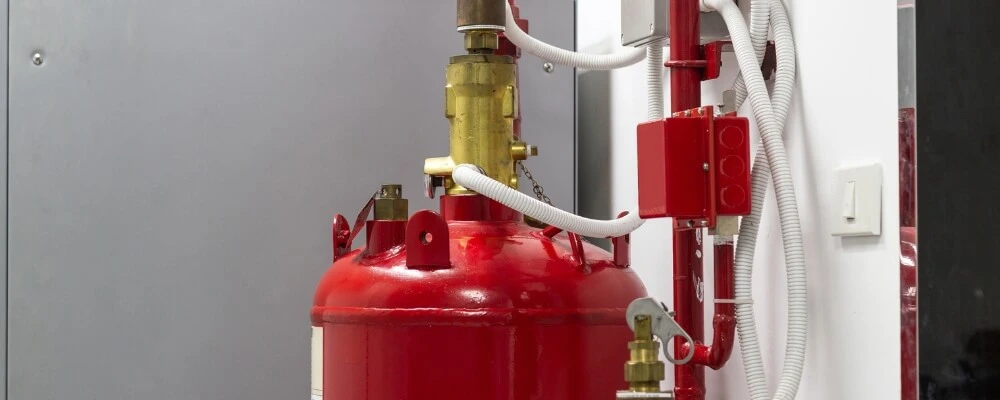
Comparison of FM-200 with Other Fire Suppression Systems
Fire suppression systems are diverse, each with its unique properties, applications, and advantages. FM-200 is one of the leading clean agent fire suppressants, but how does it stack up against other systems? Here’s a comparative analysis:
FM-200 vs. Water-Based Systems (Sprinklers):
- Residue: FM-200 leaves no residue, making it ideal for areas with sensitive equipment. Water can cause damage to electronics, documents, and other valuables.
- Speed: FM-200 discharges rapidly, often within 10 seconds, ensuring quick fire suppression. Water systems might take longer to activate and suppress fires.
- Space: FM-200 systems require less storage space compared to large water tanks or reservoirs.
- Environmental Impact: Water can lead to runoff issues, potentially causing water damage or mold growth. FM-200 has no such concerns.
FM-200 vs. CO2 Systems:
- Safety: CO2 systems work by reducing oxygen levels, which can be hazardous to humans. FM-200 suppresses fires without significantly reducing oxygen, making it safer for occupied spaces.
- Residue: Both systems are clean agents and leave no residue.
- Application: CO2 is often used in industrial settings, while FM-200 is more versatile and can be used in various environments, including offices and data centers.
FM-200 vs. Dry Chemical Systems:
- Residue: Dry chemical systems leave a powdery residue that can be challenging to clean and might damage sensitive equipment. FM-200 is residue-free.
- Effectiveness: While dry chemicals are effective against a broad range of fires, FM-200 offers rapid and clean suppression, which is especially beneficial for enclosed spaces.
- Safety: Inhalation concerns exist with dry chemicals, whereas FM-200 is generally safe for human exposure at designed concentrations.
FM-200 vs. Foam Systems:
- Residue: Foam systems leave a wet residue that requires cleanup and can cause water damage. FM-200 is clean and leaves no residue.
- Application: Foam is often used for flammable liquid fires, such as in hangars or fuel storage areas. FM-200 is more suited for enclosed spaces with electronics or valuable items.
- Environmental Impact: Some foams have environmental concerns, especially older formulations. FM-200 is considered environmentally friendly with zero ozone depletion potential.
Conclusion
In the ever-evolving landscape of fire safety, FM200 has emerged as a beacon of reliability, efficiency, and environmental responsibility. Its unique properties, from rapid, residue-free suppression to its suitability for a myriad of environments, underscore its significance in modern fire protection strategies. As we’ve journeyed through its applications, mechanisms, and comparisons with other systems, it’s evident that FM200 stands as a testament to innovation in safety.
Whether safeguarding invaluable artifacts in a museum, protecting critical data in tech hubs, or ensuring the safety of occupants in various settings, FM200 consistently proves its mettle. As we advance into an era where both safety and environmental consciousness are paramount, FM200 will undoubtedly remain a cornerstone in fire suppression solutions.

